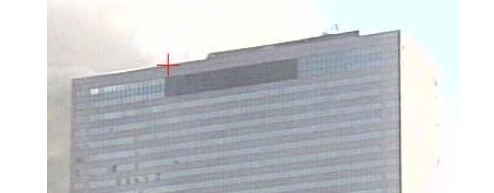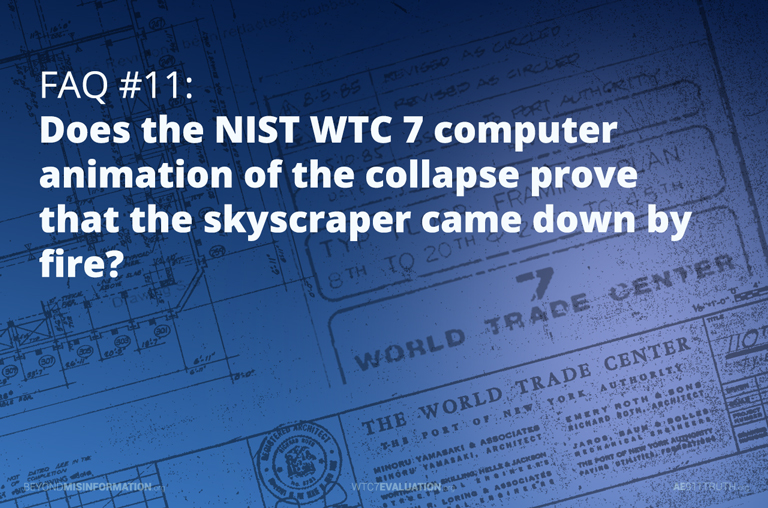The live video footage of the 'collapse' of WTC 7 undermines the credibility of NIST and their black-box computer simulation.
NIST HIDES INPUTS OF MATHEMATICAL MODELS FROM PUBLIC, MAKING ASSUMPTIONS UNVERIFIABLE
By AE911Truth Staff
The answer to this question is "No."
The NIST WTC 7 computer animation of the collapse does not even remotely resemble the observations and actual video footage of the destruction in three main ways, which are detailed below.
A scientifically valid explanation of any phenomenon must account for the key observations made of that phenomenon.
Moreover, a computer simulation does not constitute an explanation. It is merely a tool for determining and visualizing what might have happened if various assumptions are true. Yet NIST has refused to disclose the computer inputs of its mathematical models. This makes it impossible for anyone to check their work.
Here are the three reasons that we answer "No" to the question posed by this FAQ.
1. While NIST admits publicly that the building descended at “free-fall” acceleration, its computer simulation is not consistent with a building that is coming down in free fall.
NIST’s Final Report on the collapse of WTC 7 (NCSTAR 1A, p. 45) states that gravitational acceleration (free fall) of the main roofline occurred. It began when the point NIST was using[1] as its marker on the video had descended about 7 feet*. In Figure 12-62 (NCSTAR 1-9 Vol.2 p. 588) the roofline has descended about 10m /33 feet (NCSTAR 1-9A, p. 77) and the columns are still buckling in an irregular manner. Buckling columns provide resistance and would obviously prevent the building from collapsing at free-fall acceleration. The NIST computer model is clearly not simulating free-fall acceleration.
This is consistent with NIST spokesman Shyam Sunder’s statement at the WTC 7 technical briefing on August 26, 2008 (which was his initial public attempt to deny free fall along with his justification for that denial):
“. . . a free fall time would be an object that has no structural components below it. . . there was structural resistance that was provided in this particular case. And you had a sequence of structural failures that had to take place. Everything was not instantaneous.”
Given the mismatch between the NIST computer animations and the video record of the actual destruction, it is clear that NIST’s assumptions (computer inputs) were substantially in error. It was NIST’s job to explain the destruction that actually occurred, not to posit some possible way in which the destruction could have occurred. Its model, which does not reflect the observed 2.25 seconds (about 100 feet) of free fall, should be judged a complete failure, or a cover-up.
 The above computer animation is the one “with debris damage” (caused by framing sections from WTC 1). Note that the other NIST computer simulation (not shown here), which was performed “without debris damage” is irrelevant, since NIST documented that debris damage did occur.)
The above computer animation is the one “with debris damage” (caused by framing sections from WTC 1). Note that the other NIST computer simulation (not shown here), which was performed “without debris damage” is irrelevant, since NIST documented that debris damage did occur.)
* NIST's analysis ignores the fact that what appears to be a downward kink in the top of the north face of the building, in some videos, is actually an inward movement of the north-facing wall, in which the top of the wall moves away from the camera.[2]
The illusion of a downward kink[3] has been incorrectly cited by many 9/11 Truth activists as another feature of WTC 7's destruction that resembles features seen in conventional controlled demolitions. With NIST's resources and the importance of its mandate, it had no excuse for making this “mistake.” NIST knew very well, by the method that they were using, that an inward movement of the top of the north wall would be interpreted as a downward movement—because they used a point “near the middle” of the top of the wall[4] where they knew that the wall had moved inward the greatest amount, instead of using the northwest corner. This enabled NIST to show an earlier “start time” of the descent of the north face and a larger downward movement before the onset of free-fall.
 [1] and [4] North Face (Camera 3 – after collapse of the east penthouse): The NIST “point” at which they measure the descent of the building. NCSTAR 1-9, Vol. 2, p. 600
[1] and [4] North Face (Camera 3 – after collapse of the east penthouse): The NIST “point” at which they measure the descent of the building. NCSTAR 1-9, Vol. 2, p. 600
 [2] NIST’s LS-DYNA model reveals the “inward” folding north wall—prior to the downward descent of the building.
[2] NIST’s LS-DYNA model reveals the “inward” folding north wall—prior to the downward descent of the building.
 [3] The photos above are from the videos and show the north face. They are synchronized to show the conditions at the same time. The left photo is a “straight-on” shot (from about eye level at the roof line from camera 2). The photo on the right is taken from a ground-level camera 3, which shows the top of the north-facing wall folding inward (as illustrated in the NIST LS-DYNA model). Clearly the eye-level view indicates that the north face has not started to descend.
[3] The photos above are from the videos and show the north face. They are synchronized to show the conditions at the same time. The left photo is a “straight-on” shot (from about eye level at the roof line from camera 2). The photo on the right is taken from a ground-level camera 3, which shows the top of the north-facing wall folding inward (as illustrated in the NIST LS-DYNA model). Clearly the eye-level view indicates that the north face has not started to descend.
2. The NIST computer simulation does not look like the actual implosion.
The NIST computer simulation stops about one second after the building started its descent. This is completely unjustified. There is no excuse for stopping the computer animation prior to the building’s descent to the point where it drops out of sight in the video. The external frame is folding up at this point in the computer simulation, but that did not happen in the actual collapse. The only reason that NIST would have to stop the descent at this point would be to hide the obvious “folding up” and “falling over” that is beginning to occur.
Also, the “cascading” failure of the structural framing system at the three interior columns at the left side of the building, if it actually occurred, would result in a very noticeable deformation of the exterior wall, which is clearly not occurring. NIST’s hypothesis that the core columns at the east end (left) of the building failed is an unscientific fabrication.
 The live video footage of the “collapse” of WTC 7 (left) undermines the credibility of NIST and their black-box computer simulation (right).
The live video footage of the “collapse” of WTC 7 (left) undermines the credibility of NIST and their black-box computer simulation (right).
3. NIST admits that their simulation does not match the actual collapse.
“The results of this scenario were consistent with observations except that the screening wall on the roof fell downward before the west penthouse.” NCSTAR 1-9, Vol. 2, p. 612
In the NIST computer simulation, the interior columns under the screenwall and west penthouse collapse east to west in about three seconds. (These sections of the building are shown in the top-down diagram below.) However, the actual collapse progression of these columns in the video takes only about one-half of a second. While NIST acknowledged the "almost simultaneous" collapse of the screenwall and west penthouse in its 2004 Progress Report (Appendix L, pp. 34 and 44), in its computer simulation this collapse took nearly three seconds.
This is yet another example of the NIST simulation being completely inconsistent with the actual features of the destruction of this building.
 You can read the entire NIST Final Report on the Collapse of WTC 7 at:
You can read the entire NIST Final Report on the Collapse of WTC 7 at:
http://www.nist.gov/el/disasterstudies/wtc/wtc_finalreports.cfm







